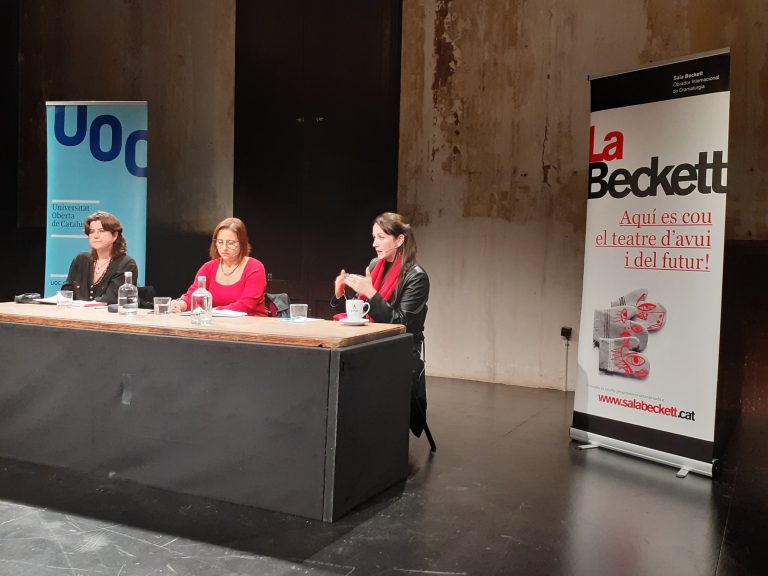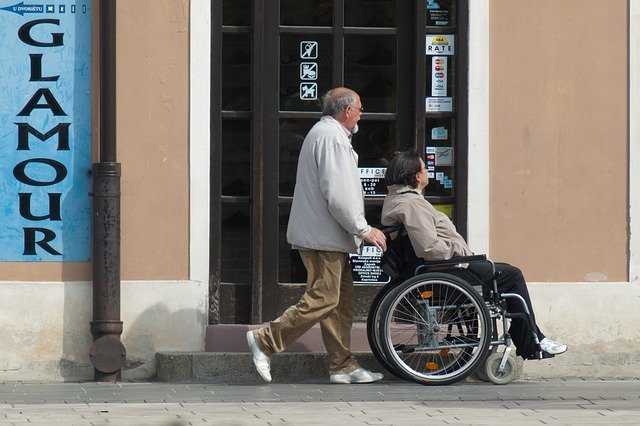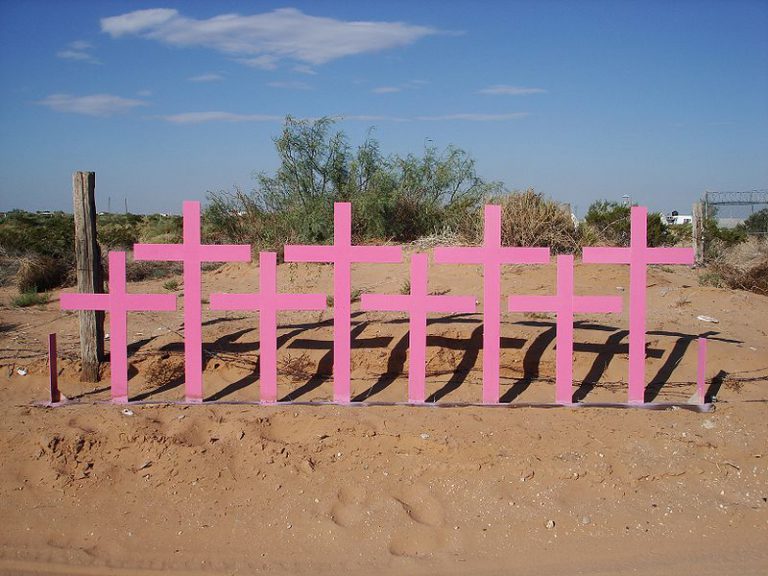The family, abuse and vulnerabilities, in the spotlight of artists and academic experts
10 January, 2023
The first round table discussion in the series entitled “The family (or the family?)”, the result of the partnership between the UOC and the Sala Beckett theatre, takes place
El cor del desig, an adaptation of Caryl Churchill’s play Heart’s Desire, directed by Lucia Del Greco, is being performed at the Sala Beckett theatre this November. To mark the performance, a round table discussion on Roles, abuses and vulnerabilities was organized on Friday 18 November. Del Greco talked with Gemma San Cornelio, from the Universitat Oberta de Catalunya (UOC) Faculty of Information and Communication Sciences, and Lídia Arroyo, a member of the Gender and ICT research group at the UOC’s Internet Interdisciplinary Institute (IN3).
Drama and reality came together in the theatre’s rehearsal room, with a dialogue between experts and the audience on the issues such as violence, silence, small acts of wilful ignorance, or the roles of family members, the victim and the abuser. This is the first of six round table discussions to focus on the family, this season’s theme at the Sala Beckett.
In 1997, before the #MeToo movement and the wave of awareness, visibility and action it brought with it, the English playwright Caryl Churchill presented Heart’s Desire, “a brave step towards condemnation of sexual and sexist abuse within families, its impact and the silence that surrounds it“, explained Lídia Arroyo, a member of the Gender and ICT research group at the IN3, during the round table discussion on Roles, abuses and vulnerabilities (18 November), which is part of the series entitled “The family (or the family?)”. It is a result of the partnership between the Sala Beckett and the UOC, which aims to create a space where thought and drama can converge.
The play, which can currently be seen at the theatre, is directed by Lucia Del Greco, who also took part in the round table discussion with Gemma San Cornelio, who teaches design and communication in the UOC’s Faculty of Information and Communication Sciences.
Del Greco, who both directed and adapted the play, has a degree in Literature and Philology from Rome’s Sapienza University and a PhD in comparative literature from Oxford University, and is a graduate of the Barcelona Theatre Institute. She said during the discussion that “when you first read it, the text is hostile. It’s difficult to understand what the play is about, and why contemporary authors work on content in this way. And the form mirrors the content.” San Cornelio argued that “like other audiovisual works and films from that historical point in time, Heart’s Desire contains a divergent and forked narrative, and there is a break in it which reminds me of Michel Gondry’s innovative video clips. Repetition is used as an aesthetic resource with finality within the play.”
Del Greco maintained that “Churchill’s text is structured in the same way, it breaks with the linear canon of text and time… and that’s because the form explains the content. I studied and read a great deal beforehand: there can obviously no longer be a static form which is independent of content in a piece of drama. The scene freezes, it goes back on itself, an imaginary situation arises, and it starts again, and it goes back again… There seems to be no way out, we enter a loop. Why? Because the content is a drama set in a family and the characters experience the past as the present (their memories and feelings), which means it’s difficult for them to look towards the future.”
Form and content
Gemma San Cornelio wondered if this constant idea of the loop that arises in the play and which sometimes occurs “as a result of repeating the same phrase with a minor change is a way of going back to the past and making a change in an attempt to fix something? The same thing happens in real life, where violence and abuse are also repetitive.”
Del Greco said that addressing form and content was a challenge. “The title, Heart’s Desire, is the father’s response to his daughter, and is an unusual expression in this situation. There is no stage direction for the sentence in the text, but I had the feeling that something strange was going on between the father and daughter, although I didn’t want to create a very negative portrait of the father, with the characteristics of an abuser. I didn’t want to place abuse explicitly at the centre“, she recalled during the discussion, but in the end, in an organic and natural way, “it happened as a result of working with the actors. A force was leading us there. We constructed the father, but also the repression, the silence, the acts of wilful ignorance that take place in the family environment – and which are constant small acts of violence in the face of something that is traumatic. This abuse that the daughter experiences is something shared: everyone in the family, especially the women, are complicit in it to some extent. There’s only one victim, and that is the person who’s abused“. Reality and the play intersect.
The characters
Apart from the daughter, who is about to return from Australia at the start of the play, there are two women who play important roles in this text. San Cornelio pointed out that the mother, a quiet figure, “becomes increasingly empowered as the play progresses, and this happens in some families where the woman is oppressed”. According to Arroyo, the character of the aunt provides a counterpoint to the mother, although she is an ambiguous character. Del Greco argued that “she is someone who’s outside the family structure, with no husband or children, which is why this is possible. Parents find it difficult to give their children any validity apart from that role, but if the aunt does it, she gives her validity as a person. But despite everything, there’s no complaint or any desire not to verbalize what’s happening.” Information is power: what is not said, what is not known, what is not shared, empowers the father in this situation.
San Cornelio also mentioned the other male character, the brother, “who’s drunk, which is why he tells the truth. He’s on the sidelines, he can’t stand the tension, and he takes the risk of speaking up.” Del Greco pointed out that for this reason, from the outset, “the father ridicules him and infantilizes him. The person who might come close to telling the truth is rejected, and isn’t given the chance to speak. They constantly ignore the brother.”
Some figures
Arroyo said that “Caryl’s text, in which the abuse isn’t presented explicitly, was written in 1997, at a point in time when sexual violence was socially silenced and normalized, despite being a widespread phenomenon. Particularly when the sexual violence took place in the private, family sphere.
The figures are significant: according to Save the Children, one in five people was sexually abused as a boy or girl. But it’s interesting to see how, in the adaptation, Lucia explicitly shows us that sexual abuse is taking place. This step forward involved in showing it may also be related to the impact that #MeToo and international movement have had, when we came out en masse to denounce this violence, and the fact is that, even in 2019, one in two women had been a victim. #MeToo led many women to begin to call sexual violence by its name, and to denounce what we were experiencing, on the street and in the media. It was global: in Chile they began to demonstrate with the slogan “You’re the rapist…” and women all over the world also took it up a week later. But, just one month later, the pandemic arrived and we went into lockdown.”
She explained that “when capitalism developed, it restricted women, as the boundaries of the public space were reserved for men, and the private space was the social place for women, as social constructs. We have previous experiences of being restricted, which are related to the sexual violence that takes place in our streets and in public spaces, and to the power of men in the public space of the labour market… Heart’s Desire, which we worked on during the pandemic, is a play about restrictions.” Lucia insisted that she made the effort not to look at the text from a gender perspective, “but it was readily apparent. The domestic space is presented as a toxic space, so the family is contaminated. And we women, who are part of it because we are all children or sisters, are also contaminated. Our identity is also based on the family. This aspect of capitalism is interesting, as Caryl talks about the family as a social structure that contains the seed of capitalism. The family and society reflect each other: society is made up of families; the members of the toxic family go out into the street, into the world… ” According to Del Greco, in the text, “this loop is a code from the beginning, but there’s a point in time – when the abuse happens – when everything freezes and the imagination, which previously offered different possible situations, now only goes to the same point. There are no longer any other possible images, because there’s no way out anymore.”
Today: the reality
The three authors talked about Jodie Foster’s film The Accused as the first depiction of the visualization of this abuse years ago, albeit in a public space and as a critique of a judicial system. San Cornelio said that “this was a highly feminist idea, but there are series today that don’t present it in that way at all. How we depict sexual violence in the audiovisual media worries me.”
Arroyo wondered whether “we’ll always be reproducing structures of patriarchal abuse. Or is change possible? There is a possibility of change in the public space, with each demonstration, for example. And in the private sphere? We all know women who have suffered from abuse, but no one knows an abuser. Where are they? For example, 72% of victims of child sexual abuse are girls, and 98% of their abusers are men with sexist attitudes. 84% of abusers are known to the victims, and 49% are members of their family. The pandemic changed things: abuse in the family is a very serious issue, and a lack of support from those around the victim, as depicted in this play – the mother’s silence about the father’s sexual abuse of his daughter – perpetuates the abuse. 33% of the people who report abuse are the victims themselves, and 28% are their mothers. And what happens to people who report abuse? The judicial system doesn’t always believe them. Those who don’t report abuse are unable to leave the loop, but those who report it… their testimony is invalid if they have marital problems, for example. How can a woman not be experiencing marital problems if she finds out that her husband, and the father of her daughter, is abusing her? Save the Children also says that children’s voices aren’t considered witness testimonies but are considered evidence. The perpetrators are acquitted in 24% of cases of child abuse. Why? In 35% of cases this is because the victims contradict themselves – really? A child or young person in a family environment, living with their abuser… of course they’re going to contradict themselves at some point! And in 15% of cases because there was consent. These reasons are cause for concern. Hopefully things are gradually changing with the new laws.”
Arroyo addressed the audience at the event and asked them a question: “Have you ever tried reporting abuse? It’s difficult in the same way that it’s difficult to recognize that abuse has taken place.” Del Greco said that “it’s dangerous and a sensitive issue, especially in the families themselves. There’s a time for silence and a time for rupture. Maybe between it happening and a name being put to it, there’s a period of time that doesn’t work in our favour [and] as soon as you verbalize it, it becomes real; you can no longer ignore it.” That’s why she believes that it is important to remember “that the responsibility lies with the abuser. It’s unlikely that someone will report themselves when they commit abuse, and that means that those of us around them are responsible in a way, even though I don’t like to talk about responsibility… Every decision is political: and so is silence, even if it arises from a burden of not knowing how to deal with what we’ve seen or what it will cause. Anyway, I believe change is possible.”
Arroyo said that “there are no figures for the scale of the complicit silence with abusers which is reflected in the play – the complicity of a woman who supports the victim but without confronting the abuser. Art and the theatre are highlighting new dimensions for which we still don’t have any empirical evidence in the social sciences.” San Cornelio added that “this play gets the message across; it deals with this drama in a sensory way, and with interesting, oppressive aesthetics.” Del Greco explained that “people laugh a lot during the first half. But there’s a change in the background noises, in how it’s interpreted, and in the second half, which has the same scenes, people don’t laugh. Our perception keeps changing with what we see in the play… but also in reality.” This, among other things, shows how art has a role to play in raising awareness and forcing change.
UOC-Sala Beckett
The family is the theme of the plays presented at the Sala Beckett theatre for this 2022-2023 season. It is also the focal point for the discussions and activities organized as result of the partnership between the UOC and the Sala Beckett. “The family (or the family?)” series of six round table discussions provides a forum for the audience, dramatists and academics from the UOC’s IN3 and its faculties of Arts and Humanities, Information and Communication Sciences, Psychology and Education Sciences. The first on Roles, abuses and vulnerabilities took place on 18 November.





